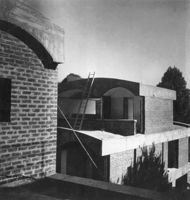Jaoul houses – Le Corbusier
Julien Tavelli & David Keshavjee (ecal)-
-

- David Kkeshavjee & Julien Tavelli for the Architectural Association, 2009
-
As young graphic designers, we studied typography and graphic design with digital
tools, and lost touch with the material constraints of the craft. Our inquiry questioned the technological evolution of building machinery and its influence on architectural creation.
We focused on the Jaoul houses in Neuilly, a chic district of Paris. For this development, Le Corbusier used only traditional building materials such as brick and tile, a strong contrast to the machinery typically necessary for modernist construction. Le Corbusier revealed a new language by using archaic construction techniques.
The architect James Stirling described the strength of Le Corbusier’s construction as ‘built by Algerian workmen equipped with ladders, hammers and nails, [the house is] technologically no more advanced over medieval building.’1
Technological progress makes creating faster and easier. But it also has a negative side that can confine us to certain aesthetics or limit our actions. Combining traditional and manual techniques with a contemporary concept allows for new shapes.
1. James Stirling, “From Garches to Jaoul: Le Corbusier as Domestic Architect in 1927 and 1953,” The Architectural Review, September 1955
-
-

- Construction of the Jaoul houses, 1954 © Photo: Lucien Hervé
-
-
-

- Algerian worker building for Le Corbusier, 1954 © Photo: FLC/ADAGP, Michel Sima
-
-
-

- James Stirling, "From Garches to Jaoul: Le Corbusier as Domestic Architect in 1927 and 1953", The Architectural Review, n° 118, 1955
-